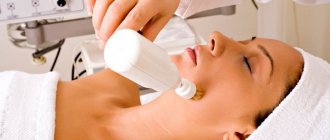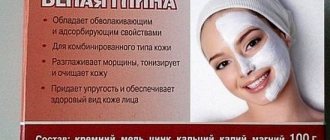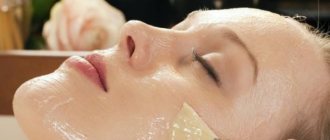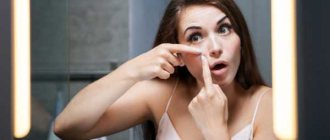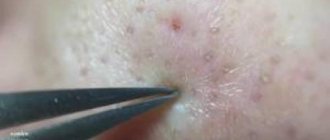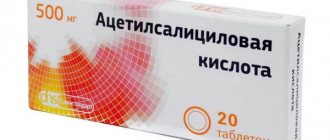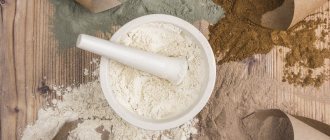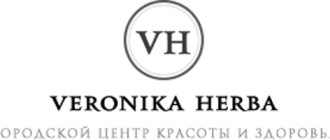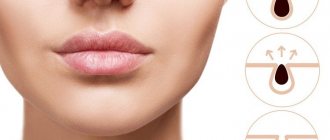Cosmetologists often encounter a situation where clients complain about the presence of blackheads that spoil their appearance. These points are localized mainly in areas where the skin is highly oily:
- - on the forehead;
- - On the nose;
- - in the area of the cheeks and wings of the nose.
It is generally accepted that these rashes - correctly called “comedones” - spoil the mood mainly of adolescents and young people under 20 years of age. Indeed, in adulthood, the problem often loses its relevance, but can periodically return - for example, during periods of strong hormonal surges. How to deal with an unpleasant phenomenon? Cosmetic clay will help - this product has already relieved many people of acne and blackheads.
Causes of blackheads
The issue of clogged skin pores most often worries those with combination/oily skin. However, people with dry and sensitive skin may also experience blackheads on their nose, cheeks, chin, and forehead. They spoil the appearance and often become inflamed, turning into pimples and boils.
Pores are clogged by epithelial cells - they tend to slough off regularly - and by thick sebum, if more is secreted than it should be. In medicine, blackheads are called comedones. They are open and closed.
Closed comedones are grayish-whitish in color and look like small nodules under the skin. It is difficult to squeeze them out; they often become inflamed. Open comedones are typical for people with wide pores. They have a gray-black color, are easily released from the contents when squeezed, and rarely become inflamed.
Causes of blackheads:
- Poor nutrition. This includes excessive consumption of sweets, fatty foods, flour, strong coffee, and alcohol.
- Poor quality skin care. This means the use of low-quality, expired cosmetics or its complete absence.
- Diseases of the gastrointestinal tract, constipation.
- Living in an area with a humid climate.
- Polluted environment.
- Smoking.
Any of the reasons can lead to excessively intense work of the sebaceous glands, which after a short time will cause the appearance of blackheads. There are several ways to tidy up your face and get rid of them:
- go to a beauty salon, paying a decent amount for the services;
- organizing a beauty salon at home by purchasing the necessary ingredients is economical and no less effective.
Clay miracle
Since ancient times, clay has been considered a healing and valuable beauty product. The product was regularly used as a lifesaver for skin that was inflamed, had a lot of rashes and blackheads, and was starting to fade and age.
Even now, when many incredible cosmetic formulas and products have been invented, clay does not lose its relevance and demand. It is easily seen as a fundamental substance in various cosmetic products. And this applies not only to budget or natural cosmetics, even expensive and famous brands use it.
Why is clay so loved by both ordinary women and cosmetics manufacturers? It's all about her positive influence:
- The product produces unsurpassed and gentle cleansing;
- Tones and refreshes;
- Improves skin color, relieves dullness and fatigue from the skin;
- Effectively dries out various inflammations and treats problem areas;
- Gently and carefully whitens.
The positive effect of clay on the skin is due to its unique composition, because it contains barium, iron, kaolin, strontium, mineral salts, quartz, magnesium and calcium.
The use of clay in cosmetology
The use of clay for skin rejuvenation and healing began several thousand years ago - in Ancient Egypt. Today this substance is actively used to relieve inflammation, cleanse pores, dry, moisturize, and nourish different skin types.
Clay of different shades is suitable for each type. Its properties are enhanced by concentrates - decoctions, infusions, juices - from medicinal plants.
Clay for the face against blackheads is used in cosmetology as masks and washes.
Varieties of colored clay
The color of clay depends on its mineral composition. It can range from pure white to black.
White clay is a natural antibiotic and has a slightly alkaline reaction. Its composition is dominated by aluminum and silicon oxides. The use of white clay in the form of masks allows you to improve your complexion, tighten your oval shape, and get rid of sagging skin in a short time.
Black clay, in addition to the classic set of microelements - manganese, calcium, aluminum and others - contains strontium and quartz. It is used to treat oily skin. Masks based on black clay normalize the functioning of the sebaceous glands, treat acne, acne, cleanse pores, rejuvenate, and provide a visible lifting effect.
Intermediate colors are due to the predominance of a certain trace element:
- Red clay from black dots contains oxides of trace elements Fe, Mg, Ca, Al, Si. The red color is given by the high content of hematite - Fe2O3. Red clay masks and washes remove free radicals and toxins from skin cells, relieve inflammation, regulate the functioning of the sebaceous glands, and moisturize. Red clay has an exfoliating effect, effectively removing particles of dead skin.
- Yellow clay from blackheads contains oxides of magnesium, iron, and potassium. There is no aluminum. Masks and washes made from yellow clay tighten pores, remove toxins from the skin, heal wounds and abrasions, and relieve inflammation.
- Green clay from blackheads contains oxides of silver, magnesium, silicon, iron, selenium, aluminum, cobalt, molybdenum. Silver oxide gives it a rich green color. The more it is, the “greener” the clay. Green clay is suitable for any skin type. It normalizes the functioning of the sebaceous glands, mattifies, moisturizes dry/sensitive skin, treats pimples, boils, acne.
- Blue clay from blackheads has a rich mineral composition. In addition to aluminum, iron, magnesium and other trace elements, it contains radium. The more it is, the “blue” the color of the clay. Masks and washes based on it relieve acne, pimples, inflammation, increase blood circulation in the upper layers of the skin, and stimulate the production of collagen and elastin.
White, black, red, yellow, green, blue clays clean pores well. With regular use of masks and washes based on them for a long time, blackheads in the T-zone can be completely eliminated.
Mask No. 3 – based on soda
You can clear blackheads at home using baking soda and salt. Thanks to the anti-inflammatory effect of soda, skin irritation is relieved. The presence of salt will help destroy comedones and remove toxins from the top layer of skin. After the procedure, blackheads are lightened, facial skin becomes smooth, matte and elastic.
Ingredients
- a pinch of soda;
- a pinch of salt;
- one spoon of water.
Soda and salt in equal proportions are thoroughly mixed and diluted with water until a homogeneous paste is obtained. Apply to a previously cleansed and steamed face. Areas with blackheads are easily massaged. Stays on for 10 minutes and washes off. The mask can greatly dry out the skin and is not recommended to be used more often than once every two weeks. After the procedure, your face should be pampered with moisturizer.
Features of using clay when working with the face
Industrially produced clay for blackheads is purchased at the pharmacy. It is presented as a finely ground powder without additives. Before using the mask, you need to work with your face so that cleansing is as effective as possible:
- Wash your face with a scrub. Use a ready-made one from a perfume store or prepare a natural one from purchased clay powder.
- Dry your face.
- Prepare the mask according to the recipe.
- Take a bath for your face. Steaming the skin is necessary to open the pores as much as possible. After this, removing sebum from them will become easier. Steam, for example, over a pan of boiled potatoes for 5 - 7 minutes.
- Apply the mask to your face using your fingers or a brush. Pay special attention to the T-zone. Do not apply the mask to the delicate skin of the eyelids, around the eyes and mouth.
- The duration of use depends on the skin type. For oily and combination skin, you need to walk with a mask for 15 - 20 minutes. You should feel a slight tightening. If the skin is sensitive or dry, reduce the duration to 5 - 10 minutes. The mask should not dry out!
Wash off any mask with slightly warm water, then rinse your face with cool water.
After removing any remaining moisture, apply a light nourishing cream. After half an hour, remove the excess with a paper napkin.
Masks and washes: ratios of ingredients
To properly prepare a classic mask, you will need clay and purified, preferably bottled, water. Clay powder is poured into water. The ratio of ingredients depends on the consistency of the final product. Clay for blackheads is diluted with water to a thick paste that does not flow, but is easily applied to the skin and dries for a long time.
To obtain a composition of this consistency, take:
- 2 - 3 tbsp. spoons of clay powder;
- 3 - 4 tbsp. spoons of water.
Leave the dishes with clay for half an hour until the water is completely absorbed. After this, mix the mixture thoroughly until smooth.
Prepare clay water for washing your face:
- Pour one tablespoon of clay into a glass of water and stir.
- Use this solution not only for washing, but also as a makeup remover, including eye makeup, or a toner.
How to prepare and apply clay masks
“Clay” cosmetics “do not like” metal containers. To prepare the healing composition, you should take the following dishes:
- - ceramic;
- - glass;
- - clay.
It is better to take a wooden spoon.
Before you get ready to relax with a clay mask on the couch, you need to prepare your face. It is necessary to wash your face and wipe your skin with cosmetic milk or cleansing gel.
Attention! You should not use scrubs first - in this case, the mask can cause excessive dryness, redness and irritation. It's better to just gently cleanse your face.
Apply so that the area around the eyes and the skin of the eyelids are not affected. It is undesirable for clay to get into your eyes. If this happens, they must be rinsed immediately with warm water.
It is better to remove the mask after it dries, that is, after 20 minutes. An exception is made for those with dry skin - they need to do this 10 minutes earlier.
To achieve results (that is, getting rid of blackheads), you need to carry out a course of such procedures lasting up to 2 months, 1 or 2 times a week.
Indications, contraindications, side effects
Clay for blackheads in masks or facial solutions is useful and has virtually no contraindications. The use of such a cosmetic product is not recommended in case of an acute infectious process of any localization, high blood pressure, or individual intolerance, which is rare.
Side effects occur if concentrates from medicinal herbs are used instead of water when preparing masks and solutions. They are caused by allergic reactions to them. Therefore, it is not recommended to replace water if there is a history of allergies to plants.
Exercise caution
But before using clay in its pure form, it is better to check it for an allergic reaction. To do this, you need to dilute a little clay with water and lubricate your wrist; if after fifteen minutes redness and swelling do not appear, then everything is fine, you can use the product.
You might be interested in reading this article: Almond oil for face against wrinkles
Despite its healing properties, clay should be used carefully, following some recommendations from cosmetologists and dermatologists:
- Apply the clay slowly, thoroughly covering all areas of the skin with a thin layer;
- It is necessary to lubricate the skin with light massage movements, avoiding the area around the eyes;
- The clay should be washed off first with warm water, and finally with cool water.
- After these simple manipulations, you need to lightly treat the skin with tonic and apply a cream or fluid for your skin type.
It should also be remembered that clay has contraindications: heart and vascular diseases, blood pressure problems, various types of tumors, diseases of the respiratory tract and circulatory system, elevated body temperature.
Cleaning your face from blackheads at home
To create a beauty salon at home you will need:
- Clay powder in the required quantity. Purchase several varieties of the substance to experiment and determine which color of clay gives the maximum effect on your skin.
- Purified water.
- A variety of medicinal herbs in accordance with the recipe for a mask or “wash”.
- Headband. It protects the hairline from getting into the clay solution.
- Glass, ceramic or plastic dishes, wooden spoon. These items are needed to mix the composition.
Metal utensils and spoons are excluded. Clay will quickly oxidize upon contact with them and lose most of its beneficial properties.
Medicinal herbs that enhance the healing effect
Face clay for blackheads is good on its own. It contains enough microelements to cleanse pores, relieve inflammation, and disinfect facial skin.
Medicinal herbs enhance this effect, so they are often used in the form of decoctions, infusions, juices that replace pure water, or mild peeling. In the latter case, clay for blackheads is mixed in the classical way using water. Pour the leaf powder of the selected herb or mixture of herbs into the mass and mix well.
If you decide to treat your skin for blackheads, you should have these ingredients on hand, depending on the recipe:
- rosemary, oil - kills pathogenic bacteria, frees the skin from free radicals, rejuvenates, treats acne, boils, blackheads, saturates dry skin with moisture;
- bergamot oil - anti-inflammatory, tightens pores, normalizes the functioning of the sweat and sebaceous glands;
- birch, leaves and buds - regulates the functioning of the sebaceous glands, provides a light matting effect;
- chamomile, herb - effectively treats pimples, blackheads, blackheads, perfectly heals wounds, disinfects;
- calendula, inflorescences - good moisturizing for dry skin, a natural antiseptic. wound healing, antibacterial, treats acne, pimples, boils;
- horsetail, green part - comprehensive care for oily skin;
- sweet clover, flowers and leaves - treats acne, boils, blackheads, kills most pathogenic bacteria, effective anti-inflammatory and cleansing;
- tea tree oil - a powerful natural antiseptic, has excellent wound-healing properties, dries out acne well, treats boils;
- aloe, leaf pulp, juice - a natural antiseptic, excellent wound healing, tonic, ideal for treating oily skin;
- butterbur, leaves and inflorescences - normalizes the functioning of the sebaceous glands, heals wounds, is a natural antihistamine, “stimulates” the immune system;
- St. John's wort, a herb - a natural antiseptic, treats acne, pimples;
- nettle, leaves and stems - cleanses, tones, heals, vitamin cocktail for oily skin
- plantain, leaves, juice - effectively treats acne, blackheads, normalizes sebum secretion;
- mint, leaves, stems - normalizes sebum secretion, has a mattifying effect;
- rowan, leaves - the best effect in the treatment of blackheads in the T-shaped zone;
- thyme, herb - moisturizing for dry and sensitive skin;
- and others.
All of the listed medicinal herbs are widespread, so you can collect them yourself. Rosemary, bergamot and tea tree oils are easier to buy at the pharmacy.
Green and blue clay mask against blackheads for oily skin with tea tree and lemon juice
To prepare it you will need:
- green and blue clay for blackheads - 1 tbsp. spoon;
- decoction of rowan leaves - 3 tbsp. spoons;
- tea tree oil - a couple of drops;
- juice of half a small lemon.
Before preparing the mask, cleanse the skin using a solution of red clay - stir 1 tablespoon of powder in half a glass of purified water. Dip a sponge into the solution, apply clay to the T-shaped area and massage gently. Leave for a couple of minutes, wash with a decoction of chamomile.
Prepare the mask:
- Mix green and blue clay.
- Grind the rowan leaves, pour boiling water over them, boil for 10 minutes, set aside to steep, strain, and cool.
- Pour the clay into the broth and let it sit for half an hour.
- Add tea tree oil, squeeze lemon juice, mix well.
- Apply the resulting mixture onto your face with your fingers, be sure to work on your forehead, cheeks, nose and chin.
- Take a horizontal position and rest for 10 minutes.
- Wash your face with cool water with the addition of a decoction of chamomile.
Black clay mask for oily skin, drying and tightening pores with rosemary and bergamot oils
To cook it. You need to stock up on the following ingredients:
- black clay powder - 3 tbsp. spoons;
- aloe juice - 1 tbsp. spoon;
- infusion of a mixture of medicinal herbs: mint, butterbur, horsetail, nettle, sweet clover - 3 tbsp. spoons;
- rosemary and bergamot oil - a couple of drops of each.
The mask is prepared in the usual way:
- The day before, prepare an infusion of herbs: take them in equal proportions, pour boiling water over them, wrap them up and let them cool naturally for 8 - 10 hours. Once completely cooled, place in the refrigerator.
- Twist the aloe leaf in a meat grinder and squeeze out the juice.
- Mix herbal infusion and aloe juice in the required quantity.
- Pour clay into the mixture and stir.
- Add rosemary and bergamot oils and stir again.
- Wash your face with warm water and dry your face.
- Apply the clay, paying close attention to the T-shaped area.
- Lie down for 15 - 20 minutes.
- Wash your face with cool water, rinse your face with the herbal decoction you used to prepare the mask.
Herbal mask against blackheads for dry skin
Dry skin is very sensitive to clay masks. Therefore, it is better to cook them with herbs that have a soothing and moisturizing effect. To make the mask, prepare the following ingredients:
- white clay for blackheads, powder - 4 tbsp. spoons;
- decoction of herbs: sweet clover, St. John's wort, thyme in equal quantities - 4 tbsp. spoons;
- a couple of drops of rosemary oil;
- one egg yolk.
You need to be careful when working with dry skin:
- Prepare a decoction of medicinal herbs and cool it.
- Mix all ingredients except the yolk into a homogeneous mass.
- Add the yolk and mix again.
- Apply the mask to your face.
- Take a horizontal position for 5 - 10 minutes and relax.
- Wash your face with cool water, then rinse your face with the remaining broth.
- Gently pat your skin dry with a soft towel and apply a light soothing cream.
Video recipe
Other Ways to Clean Dirty Pores
If you don’t have clay on hand, but you have oatmeal or oatmeal and an onion, you can make a mask from them:
- Pour half a cup of cereal into a cup.
- Grind the onion head in a meat grinder.
- Mix the ingredients. If it is too dry, add a little purified water to get the mixture to the desired consistency.
- Place the mask on your face. The procedure lasts approximately 10 minutes, rinse off.
- Rub your skin with an ice cube. Make it from parsley juice - grind the greens in a meat grinder, squeeze out the juice, fill an ice tray with it and place it in the freezer.
When treating blackheads, change your lifestyle - eat right, take care of your face every day, and lead an active lifestyle. This will normalize metabolism and improve blood circulation.
Source
Mask No. 2 – based on kefir
It is difficult for other products to compete with the soothing ability of kefir. Dietary fermented milk product relieves irritation of the epidermis. The addition is another useful element - oatmeal. Rich in vitamins, proteins and microelements, they fill the upper layers of the skin with essential nutrients. Masks for blackheads can easily penetrate deep into pores and remove impurities. To prepare at home, you need simple ingredients.
Ingredients
- a spoonful of rolled oats;
- a spoonful of finely ground table salt;
- a couple of spoons of kefir.
The flakes need to be ground in a blender or using a hand mill. Add salt, stir. Dilute the resulting mixture with heated kefir to make a paste, like thick sour cream. The mask against blackheads is applied to the face. Exposure time is 15-20 minutes. The effect of the mask can be compared to the most delicate peeling.
